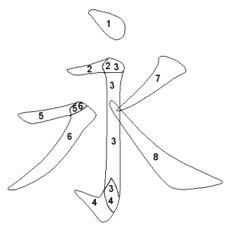Sanzui
Toward the end of the December newsletter, I presented a sign for a business called さんずい:

Photo Credit: Yasutaka Inaba
The name is not a word. It's not even a single character. Rather, it's the "water" radical 氵 when it appears on the left side of a kanji. How radical to name something after a radical!
Three people run that business, including my friend Keiko Murate, and I asked her why they chose that name. Here's what she said, along with translations.
The Idea Behind the Name Sanzui
理由はいくつもありますよ!
There are many reasons!
まず、私たち三人が住んでいる地域には「隅田川」という川が流れています。
First of all, the three of us live near the Sumida River.
歴史や文化や生活に関わる大事な川なので、「川」や「水」を感じる名前にしたかったのです。
The river has been important in history, in culture, and in people's daily lives, so we wanted a name that gave off the feeling of 川 (river) and 水 (water).
そして、三人でやっていることを表す名前が良かったので、そこから「氵」を思いつきました。
And then we thought it would be good to have a name reflecting that three of us are doing (this business), so we hit on 氵.
また、三つのパーツから成り立っている「氵」の形は、上に二つの点があって、下に一つの右上払いから出来ています。
And it has three parts—the two dots on top and the sweeping stroke that goes to the upper right.
ケータリングの料理を担当するレストランと、デザートを担当するカフェ、この二店を、デザインを担当する私がよりよく見せて、ぐっと持ち上げる、という三人の役割を表す記号としても合っていると思いました!
I work with two shops: the restaurant doing the catering and the cafe doing the desserts. I do the designs, making them look better and “lifting them up." I thought this symbol would do a good job of representing our three roles.
❖❖❖
A Sweeping Stroke Called 払い
My proofreader astutely notes that Keiko's "lifting them up" comment connects to the way the third stroke of氵rises.
Let's go back to the paragraph just before that:
また、三つのパーツから成り立っている「氵」の形は、上に二つの点があって、下に一つの右上払いから出来ています。
And it has three parts—the two dots on top and the sweeping stroke that goes to the upper right.
What's this? A kanji term I've never heard before?! The word 払い (はらい: sweeping stroke (e.g., when writing kanji)) comes from the verb 払う (はらう), which means "to sweep" just as often as it means "to pay," says my proofreader. (It does?) When writing 払, one moves the brush as if one were sweeping something. (I like that!) The noun form 払い (はらい) can therefore mean both “sweeping” and “payment." (Paying is like sweeping something under the rug?!)
To explain more about the sweeping stroke 払い, my proofreader notes that there are eight basic kanji strokes, collectively referred to as follows:
永字八法 (えいじ はっぽう: the eight basic brushstrokes in drawing Chinese characters)
The idea behind this term is that one needs all eight strokes to draw the kanji 永 (eternity). What a relief it must be to calligraphers that an auspicious character meets that requirement, rather than, say, 尻 (buttocks)!
The following image shows the eight strokes:

Wikipedia refers to strokes 6 through 8 as はらい, "sweeping strokes." The same source explains that in 6 through 8, the strokes gently curve and taper off at the end.
Strokes 6 and 7 look pretty similar, and in fact Wikipedia describes 7 as a short version of 6.
The third stroke of さんずい shares this curving and tapering quality, so it qualifies as はらい.
By the way, I was initially confused by this part of Keiko's comment:
下に一つの右上払いから出来ています
the sweeping stroke that goes to the upper right.
With 〜払い, as I learned, the 〜 indicates the direction in which the stroke is going (右上 in this case).
How intricately thought out all this is. But of course! That's why the Japanese excel at design and craftsmanship! And I can't help but think that attentiveness to every last stroke and dot of kanji fosters this kind of precise attention to detail!
As long as we're in a precise frame of mind, I want to announce the publication of the newest essay, which is about a kanji that should appeal very much to neatniks:
Catch you back you here next week!
❖❖❖
Did you like this post? Express your love by supporting Joy o' Kanji on Patreon:



Comments